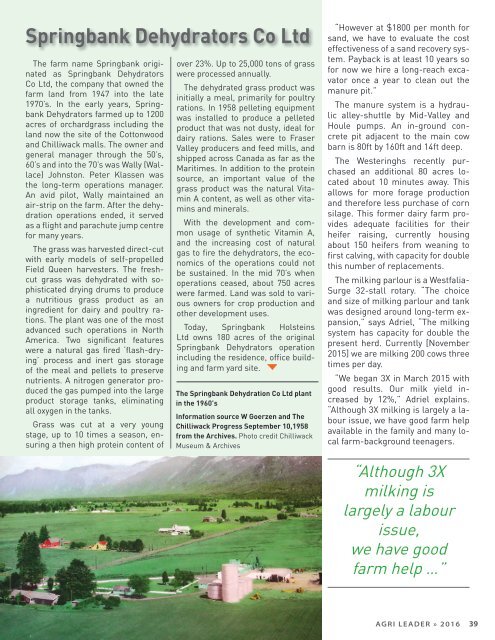Create successful ePaper yourself
Turn your PDF publications into a flip-book with our unique Google optimized e-Paper software.
Springbank Dehydrators Co Ltd<br />
The farm name Springbank originated<br />
as Springbank Dehydrators<br />
Co Ltd, the company that owned the<br />
farm land from 1947 into the late<br />
1970’s. In the early years, Springbank<br />
Dehydrators farmed up to 1200<br />
acres of orchardgrass including the<br />
land now the site of the Cottonwood<br />
and Chilliwack malls. The owner and<br />
general manager through the 50’s,<br />
60’s and into the 70’s was Wally (Wallace)<br />
Johnston. Peter Klassen was<br />
the long-term operations manager.<br />
An avid pilot, Wally maintained an<br />
air-strip on the farm. After the dehydration<br />
operations ended, it served<br />
as a flight and parachute jump centre<br />
for many years.<br />
The grass was harvested direct-cut<br />
with early models of self-propelled<br />
Field Queen harvesters. The freshcut<br />
grass was dehydrated with sophisticated<br />
drying drums to produce<br />
a nutritious grass product as an<br />
ingredient for dairy and poultry rations.<br />
The plant was one of the most<br />
advanced such operations in North<br />
America. Two significant features<br />
were a natural gas fired ‘flash-drying’<br />
process and inert gas storage<br />
of the meal and pellets to preserve<br />
nutrients. A nitrogen generator produced<br />
the gas pumped into the large<br />
product storage tanks, eliminating<br />
all oxygen in the tanks.<br />
Grass was cut at a very young<br />
stage, up to 10 times a season, ensuring<br />
a then high protein content of<br />
over 23%. Up to 25,000 tons of grass<br />
were processed annually.<br />
The dehydrated grass product was<br />
initially a meal, primarily for poultry<br />
rations. In 1958 pelleting equipment<br />
was installed to produce a pelleted<br />
product that was not dusty, ideal for<br />
dairy rations. Sales were to Fraser<br />
Valley producers and feed mills, and<br />
shipped across Canada as far as the<br />
Maritimes. In addition to the protein<br />
source, an important value of the<br />
grass product was the natural Vitamin<br />
A content, as well as other vitamins<br />
and minerals.<br />
With the development and common<br />
usage of synthetic Vitamin A,<br />
and the increasing cost of natural<br />
gas to fire the dehydrators, the economics<br />
of the operations could not<br />
be sustained. In the mid 70’s when<br />
operations ceased, about 750 acres<br />
were farmed. Land was sold to various<br />
owners for crop production and<br />
other development uses.<br />
Today, Springbank Holsteins<br />
Ltd owns 180 acres of the original<br />
Springbank Dehydrators operation<br />
including the residence, office building<br />
and farm yard site.<br />
The Springbank Dehydration Co Ltd plant<br />
in the 1960’s<br />
Information source W Goerzen and The<br />
Chilliwack Progress September 10,1958<br />
from the Archives. Photo credit Chilliwack<br />
Museum & Archives<br />
“However at $1800 per month for<br />
sand, we have to evaluate the cost<br />
effectiveness of a sand recovery system.<br />
Payback is at least 10 years so<br />
for now we hire a long-reach excavator<br />
once a year to clean out the<br />
manure pit.”<br />
The manure system is a hydraulic<br />
alley-shuttle by Mid-Valley and<br />
Houle pumps. An in-ground concrete<br />
pit adjacent to the main cow<br />
barn is 80ft by 160ft and 14ft deep.<br />
The Westeringhs recently purchased<br />
an additional 80 acres located<br />
about 10 minutes away. This<br />
allows for more forage production<br />
and therefore less purchase of corn<br />
silage. This former dairy farm provides<br />
adequate facilities for their<br />
heifer raising, currently housing<br />
about 150 heifers from weaning to<br />
first calving, with capacity for double<br />
this number of replacements.<br />
The milking parlour is a Westfalia-<br />
Surge 32-stall rotary. “The choice<br />
and size of milking parlour and tank<br />
was designed around long-term expansion,”<br />
says Adriel, “The milking<br />
system has capacity for double the<br />
present herd. Currently [November<br />
2015] we are milking 200 cows three<br />
times per day.<br />
“We began 3X in March 2015 with<br />
good results. Our milk yield increased<br />
by 12%,” Adriel explains.<br />
“Although 3X milking is largely a labour<br />
issue, we have good farm help<br />
available in the family and many local<br />
farm-background teenagers.<br />
“Although 3X<br />
milking is<br />
largely a labour<br />
issue,<br />
we have good<br />
farm help …”<br />
AGRI LEADER » 2016<br />
39


